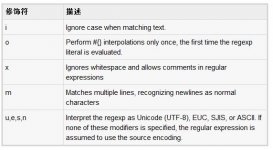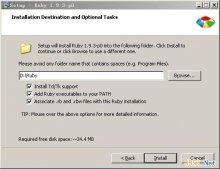获取当前日期和时间:
以下是一个简单的例子,以获得当前的日期和时间:
|
1
2
3
4
5
6
7
8
9
|
#!/usr/bin/ruby -wtime1 = Time.newputs "Current Time : " + time1.inspect# Time.now is a synonym:time2 = Time.nowputs "Current Time : " + time2.inspect |
这将产生以下结果:
|
1
2
|
Current Time : Mon Jun 02 12:02:39 -0700 2008Current Time : Mon Jun 02 12:02:39 -0700 2008 |
获取组件的日期和时间:
我们可以用 Time 对象来获取日期和时间的各个组成部分。下面的例子显示相同的:
|
1
2
3
4
5
6
7
8
9
10
11
12
13
14
15
16
|
#!/usr/bin/ruby -wtime = Time.new# Components of a Timeputs "Current Time : " + time.inspectputs time.year # => Year of the date puts time.month # => Month of the date (1 to 12)puts time.day # => Day of the date (1 to 31 )puts time.wday # => 0: Day of week: 0 is Sundayputs time.yday # => 365: Day of yearputs time.hour # => 23: 24-hour clockputs time.min # => 59puts time.sec # => 59puts time.usec # => 999999: microsecondsputs time.zone # => "UTC": timezone name |
这将产生以下结果:
|
1
2
3
4
5
6
7
8
9
10
11
|
Current Time : Mon Jun 02 12:03:08 -0700 200820086211541238247476UTC |
Time.utc,Time.gm和Time.local函数:
可用于这两个函数以标准格式来格式化日期如下:
|
1
2
3
4
5
6
7
8
|
# July 8, 2008Time.local(2008, 7, 8) # July 8, 2008, 09:10am, local timeTime.local(2008, 7, 8, 9, 10) # July 8, 2008, 09:10 UTCTime.utc(2008, 7, 8, 9, 10) # July 8, 2008, 09:10:11 GMT (same as UTC)Time.gm(2008, 7, 8, 9, 10, 11) |
下面的例子,在一个数组来获取所有组件按以下格式:
|
1
|
[sec,min,hour,day,month,year,wday,yday,isdst,zone] |
尝试以下操作:
|
1
2
3
4
5
6
|
#!/usr/bin/ruby -wtime = Time.newvalues = time.to_ap values |
这将产生以下结果:
|
1
|
[26, 10, 12, 2, 6, 2008, 1, 154, false, "MST"] |
这个数组可以传递给Time.utc或Time.local函数得到不同的日期格式如下:
|
1
2
3
4
5
6
|
#!/usr/bin/ruby -wtime = Time.newvalues = time.to_aputs Time.utc(*values) |
这将产生以下结果:
|
1
|
Mon Jun 02 12:15:36 UTC 2008 |
跟随着的方式来获得内部表示(依赖于平台)历元以来的秒数时间:
|
1
2
3
4
5
6
7
8
|
# Returns number of seconds since epochtime = Time.now.to_i # Convert number of seconds into Time object.Time.at(time)# Returns second since epoch which includes microsecondstime = Time.now.to_f |
时区和夏令时:
可以使用一个 Time 对象来获取相关的所有信息的时区和夏令如下:
|
1
2
3
4
5
6
7
8
9
10
11
12
|
time = Time.new# Here is the interpretationtime.zone # => "UTC": return the timezonetime.utc_offset # => 0: UTC is 0 seconds offset from UTCtime.zone # => "PST" (or whatever your timezone is)time.isdst # => false: If UTC does not have DST.time.utc? # => true: if t is in UTC time zonetime.localtime # Convert to local timezone.time.gmtime # Convert back to UTC.time.getlocal # Return a new Time object in local zonetime.getutc # Return a new Time object in UTC |
格式化时间和日期:
有各种各样的方式来格式化日期和时间。下面是一个例子,说明几个:
|
1
2
3
4
5
6
7
|
#!/usr/bin/ruby -wtime = Time.newputs time.to_sputs time.ctimeputs time.localtimeputs time.strftime("%Y-%m-%d %H:%M:%S") |
这将产生以下结果:
|
1
2
3
4
|
Mon Jun 02 12:35:19 -0700 2008Mon Jun 2 12:35:19 2008Mon Jun 02 12:35:19 -0700 20082008-06-02 12:35:19 |
时间算术:
可以在时间上做简单的算术如下:
|
1
2
3
4
5
6
7
8
9
10
11
|
now = Time.now # Current timeputs nowpast = now - 10 # 10 seconds ago. Time - number => Timeputs pastfuture = now + 10 # 10 seconds from now Time + number => Timeputs futurediff = future - now # => 10 Time - Time => number of secondsputs diff |
这将产生以下结果:
|
1
2
3
4
|
Thu Aug 01 20:57:05 -0700 2013Thu Aug 01 20:56:55 -0700 2013Thu Aug 01 20:57:15 -0700 201310.0 |




